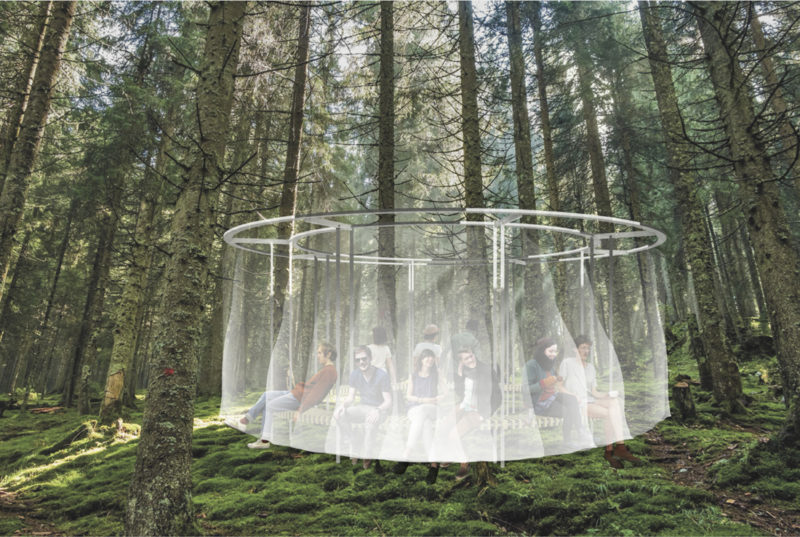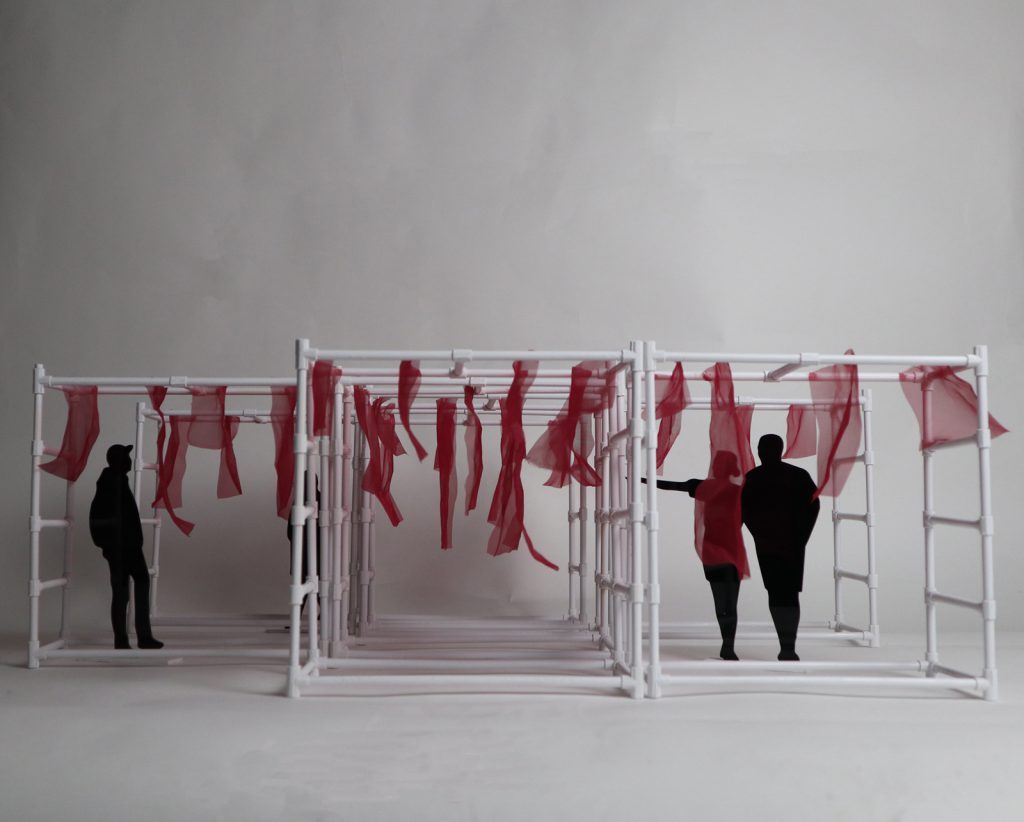Experience and the Object: Experiments in Relational Art & Architecture
27 May 2021By Laura Beshears

I step slowly into a long corridor of vertically aligned PVC pipes in two straight lines, the synthetic material contrasting with the forest surrounding it. With the view around me obscured by the structure, which grows incrementally taller as I walk through it, I direct my gaze up toward the sky and become attuned to the sounds of twigs breaking beneath my feet and wind whirring through leaves. The path leads to a larger clearing of space – although walls of PVC pipes still surround it – and I join others who had taken the same meditative stroll moments before me. I linger, beholding the canopy of trees above and letting the soundscape of nature envelope me. I exit and find myself back in the forest, but with a different sensibility. Calm and at ease, I take pleasure in having encountered nature through an innovative sensory lens.
So describes an experience that exists only in my imagination, an envisioning ignited not by inhabiting a real structure in space but rather by viewing a representation of one. This representation, P.V.C. Pavilion (2020) by Gurkiran Gill and Carlo Reyes, is among several outdoor pavilions envisaged and rendered by the students of Bill Pechet’s design studio class at the University of British Columbia (UBC) during their two-week collaboration with Vancouver-based artist and curator Holly Schmidt in the spring of 2020. As part of her residency with UBC’s Outdoor Art Program at the Morris and Helen Belkin Art Gallery–titled Vegetal Encounters, running through 2021–Schmidt is initiating projects with students, faculty, and staff that create opportunities for individuals to build deeper connections with their natural world, particularly with the plant life around them.
This particular collaboration, named Spacio-Vegetal Encounters by Pechet as a riff on the title of Schmidt’s residency, entailed Pechet’s students working in small groups to design a nomadic pavilion that Schmidt could potentially build and install on UBC’s campus. A consideration of this joint art and architectural venture unveils an intricate endeavor, in which a project exists within a project. As a whole, the collaboration is emblematic of the trend in contemporary art toward participatory and multi-sensory engagement, yet it engenders new conversation around some of the issues and critiques that have typically accompanied such interactive artistic undertakings, while offering insight into the status of the object in contemporary conceptual art.
Schmidt’s practice operates within the realm of relational aesthetics, a term coined by French critic and curator Nicolas Bourriaud to describe a category of art that emerged in the 1990s with artists such as Rirkrit Tiravanija and Liam Gillick. Relational artists share a desire to construct spaces for individuals to gather together and relate to one another. Whether it entails cooking pad thai for visitors to enjoy over conversation or building colorful Plexiglas walls and screens to delineate areas for interaction and dialogue, relational art centres on the idea of shared experience and, as such, relies on the participation of the viewer for its completion. Schmidt’s projects continue the legacy of relational aesthetics by extending it to the natural world. In her 2012 project The Moveable Feast, the artist assembled a garden with planters, tables, and benches as a site for growing vegetables and facilitating group activities such as cheese-making demonstrations and honey tastings. Other past projects have motivated social engagement through guided nature walks, group meals, papier-maché workshops, and collective star-gazing.

However, Schmidt’s work broadens the concept of relational aesthetics in an important respect. As Claire Bishop stresses, “relational art works insist upon use rather than contemplation.” (1) Relational aesthetics prioritizes art’s ability to incite social interaction, between artist and audience as well as between viewers, over its ability to provoke private response or reflection. While Schmidt is similarly committed to art as a social practice, her work simultaneously encourages personal experience. Her practice is concerned less with the interactions between humans than with the complex relationships between humans and their natural environments. Her endeavors inspire individuals to reflect on their nuanced connections with nature, examine their positions and roles within their environs, and engage with their physical surroundings through different sensorial means. Schmidt continually navigates between the realms of collective engagement and individual experience such that her projects accommodate both use and contemplation. Her brand of relational aesthetics aspires not only to connect people with people but also to connect people with nature.
The collaboration between Schmidt and Pechet’s class exemplifies this expanded realm of relational aesthetics. Spacio-Vegetal Encounters, like other works of relational art, embodies a flexible and open-ended approach while requiring viewer participation and interaction. On one level, Schmidt and Pechet tasked the student teams with designing a mobile pavilion that would enable both group gatherings and moments of personal communion with nature. In this way, students had the opportunity to generate innumerable imagined pavilions, and their work produced a wide array of architectural responses that could, together and individually, assume various physical formats and engender many possibilities for user engagement. In their project Oasis (2020), for example, Megan Berry, Robert Ferguson, and Narita Ico designed a circular bench around which participants could face either outward for an individual experience with nature or inward for a group discussion. In another group, Samantha Bush, Richard Ranta, and Kirrily Saich proposed stretching recycled fishing netting over a frame of bamboo branches to create forms resembling folding screens, which could serve as either seating for individuals to lean against or walls for setting up loose boundaries of space. As both projects demonstrate, the open-ended assignment of Spacio-Vegetal Encounters called for students to model relational aesthetics in their designs.
On another level, the collaboration itself–between the artist, the professor, and the students–also embodies relational aesthetics. After receiving their assignment and venturing out on a group walk with Schmidt, where they learned about the artist’s practice and experienced her methods first-hand, the students workshopped their designs in collaboration with Schmidt and Pechet, as well as with feedback from a few invited critics. The students, in this sense, served as the participants who activated Schmidt’s relational art. Spacio-Vegetal Encounters exists, then, as an artwork within an artwork, where students partook in relational aesthetics at the same time as they explored different means of producing it. As a whole, the project places emphasis on experience and process, another attribute that exemplifies Spacio-Vegetal Encounters’ open-ended nature and establishes its function as a work of relational art.
Beyond demonstrating a nuanced instance of relational aesthetics, however, Spacio-Vegetal Encounters also foregrounds some of the problems that have been associated with this art form since its origins. In her critique of Bourriaud’s characterization of relational aesthetics, Bishop challenges his assertion that relational art produces “microtopias,” where viewers partake in a collective experience that brings them together as a community, by questioning the nature of the interactions and dialogues engendered as well as the assumption that they are necessarily “democratic and therefore good.” (2) Part of the problem stems from context for the art pieces, and Bishop is wary of the trend of art museums toward hosting spaces that act as laboratories or studios for relational art to carry out its processes. She remarks that “in this context, project-based works-in-progress and artists-in-residence begin to dovetail with an ‘experience economy,’ the marketing strategy that seeks to replace goods and services with scripted and staged personal experiences.” (3) Relational aesthetics, she suggests, is susceptible to becoming a consumer product.
Spacio-Vegetal Encounters resists this eventuality in more ways than one. Schmidt brings the project outside of the museum context and into the realms of the classroom and, importantly, nature. While the social aspect of Schmidt’s practice and, by extension, Spacio-Vegetal Encounters is important, intersubjectivity is neither the only nor the primary goal: the focus remains on nature and human engagement with and within it. The aim of Spacio-Vegetal Encounters, in both of its manifestations as a collaboration and an assignment, is not to create “microtopias” but for individuals to discover means through which to broaden their perceptions of their physical surroundings. Ultimately, the project dodges categorization as a consumer product because there is no product for consumption. The nomadic pavilion is not built but envisioned. A marketable object does not exist, as these pavilions live only in representation, through renderings and small mock-ups created by the students. While it could be argued that the product is the experience of the collaboration between Schmidt and Pechet’s students, the other aspect of Spacio-Vegetal Encounters–the experience of the pavilion–can only be imagined, not lived.

At the same time, despite the absence of a physical pavilion, Spacio-Vegetal Encounters speaks volumes about the role of the object, as well as its aesthetic and form, in relational art and conceptual art more broadly. Relational aesthetics stems from an artistic agenda that seeks to de-emphasize the art object. Whereas minimalist sculpture sheds itself of ornament and content as a means to transfer focus from the object to the viewer’s experience of the object, conceptual art more firmly rejects the notion of art as object in favor of art as idea. In requiring viewer participation and prioritizing the viewer’s experience over all else, relational art further deflates the status of the object. Spacio-Vegetal Encounters seemingly follows this same trajectory. The collaborative project centres on experience, particularly on the participant’s experience in and with nature. Additionally, while there is the context of the classroom, the other object–in this case, the pavilion–is materially absent. And yet, in a major departure from its precedents, the object in Spacio-Vegetal Encounters (even in its physical absence) factors crucially into the collaboration. Pechet’s students needed to think carefully about the pavilion and its physical manifestation in determining how the object would impact and shape user experience. In a complicated twist, Spacio-Vegetal Encounters brings the object back into focus.
The Spacio-Vegetal Encounters assignment obliged students to reflect not only on the object but also on its many facets and details, including the pavilion’s form, material, and function. In The Komorebi (2020), for instance, students David Law, Kaia Nielsen-Roine, and Oluwatosin Odugbemi planned to iron a layered assortment of recycled plastic into large petal- or leaf-like forms and adhere them to the top of a structure of arched wooden beams. The plastic petals could sway in the wind and produce fluctuating effects of light and shade, drawing hypothetical viewers’ attention to the subtle influences of sun and air on the environment. With Scaffolding (2020), as another example, group members Sophie Lindheimer, Pauline Salonga, and Kendra Yoshizawa utilized the common support structure of the scaffold as a modular unit that Schmidt could arrange in a wide array of configurations. Whether positioned to define a more enclosed area or organized to provide an open field of space, the scaffolding would suit Schmidt’s desire for a place to gather people together yet could also direct their attention to nature. In striving to design a pavilion that would engender participation and multi-sensory engagement, students necessarily had to focus on the pavilions themselves. The pavilions’ appearance, their material shape and make-up, their textures and surfaces, and their utilization and framing of space were all essential elements that could structure and influence the human experience to be had in and around them. While it might be an overstatement to declare the return of the object in art, Spacio-Vegetal Encounters elevated the status of the object through stressing the significance of its aesthetic and form in achieving the goals of participation and experience in relational art.
Spacio-Vegetal Encounters serves as a complex interpretation of relational art that operates on many levels. It provided an opportunity for students to learn how to produce relational aesthetics through design while itself existing as a collaboration that can continue to generate conversation and interaction. It involves both lived and imagined experiences. It straddles the line between conceptual and object-based art. Moreover, it is still in process. Schmidt may choose to realize a specific proposal, build a pavilion of her own design, or decide not to materialize the pavilion at all. Yet, irrespective of its outcome, Spacio-Vegetal Encounters has already pushed the boundaries of relational aesthetics and contributed to new understandings of the implications of the object, aesthetics, and form within conceptual art.
- Claire Bishop, “Antagonism and Relational Aesthetics,” October 110 (Autumn 2004): 55.
- Ibid., 65.
- Ibid., 52.
Spacio-Vegetal Encounters is a project by artist Holly Schmidt, and was in collaboration with Bill Pechet’s design studio class at the University of British Columbia from February 25 – March 13, 2020.
Feature Image: Scaffolding, 2020 by Sophie Lindheimer, Pauline Salonga, and Kendra Yoshizawa. Photo courtesy of the UBC School of Architecture and Landscape Architecture.



